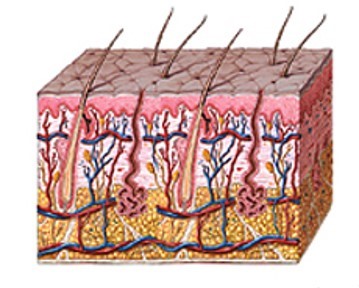Impetigo - skin infection
Table of content
Causes
Symptoms
Exams and Tests
Treatment
Outlook (Prognosis)
Possible Complications
When to Contact a Medical Professional
Prevention
Impetigo is a common skin infection.

Figure: Skin structure
Causes
Impetigo is caused by streptococcus (strep) or staphylococcus (staph) bacteria. Methicillin-resistant staph aureus (MRSA) is becoming a common cause.
The skin normally has many types of bacteria on it. When there is a break in the skin, bacteria can enter the body and grow there. This causes inflammation and infection. Breaks in the skin may occur with:
-
Animal bites
-
Human bites
-
Injury or trauma to the skin
-
Insect bites
Impetigo may also occur on skin where there is no visible break.
It is most common in children who live in unhealthy conditions.
In adults, it may occur following another skin problem. It may also develop after a cold or other virus.
Impetigo can spread to others. You can catch the infection if the fluid that oozes from the blisters touches an open area on your skin.
Symptoms
Symptoms of impetigo are:
-
One or many blisters filled with pus that are easy to pop. In infants, the skin is reddish or raw-looking where a blister has broken.
-
Blisters that itch:
-
Filled with yellow or honey-colored fluid
-
Oozing and crusting over
-
Rash that may begin as a single spot, but spreads to other areas with scratching
-
Skin sores on the face, lips, arms, or legs, that spread to other areas
-
Swollen lymph nodes near the infection
Exams and Tests
Your health care provider will look at your skin to determine if you have impetigo.
The health care provider may take a sample of bacteria from your skin to grow in the lab.This can help determine if MRSA is the cause. Specific antibiotics are needed to treat this type of bacteria.
Treatment
The goal is to cure the infection and relieve the symptoms.
Your doctor will prescribe an antibacterial cream. You may need to take antibiotics by mouth if the infection is severe.
Wash (do not scrub) the skin several times a day with an antibacterial soap to remove crusts and drainage.
Outlook (Prognosis)
The sores of impetigo heal slowly. Scars are rare. The cure rate is very high, but the problem often comes back in young children.
Possible Complications
-
Kidney failure (post-streptococcal glomerulonephritis) (rare)
-
Many patches of impetigo (in children)
-
Permanent skin damage and scarring (very rare)
-
Spread of the infection to other parts of the body (common)
When to Contact a Medical Professional
Call your health care provider if you have symptoms of impetigo.
Prevention
Prevent the spread of infection.
-
If you have impetigo, always use a clean washcloth and towel each time.
-
Do not share towels, clothing, razors, and other personal care products with other family members.
-
Avoid touching blisters that are oozing.
-
Wash your hands thoroughly after touching infected skin.
Keep your skin clean to prevent getting the infection. Clean minor cuts and scrapes well with soap and clean water. You can use a mild antibacterial soap.
Source: http://www.nlm.nih.gov/medlineplus/ency/article/000860.htm


 Общие симптомы
Общие симптомы  Голова, зрение, слух, речь
Голова, зрение, слух, речь  Шея и горло
Шея и горло  Грудь, сердце и дыхание
Грудь, сердце и дыхание  Живот, желудок, кишечник
Живот, желудок, кишечник  Конечности, суставы, спина, поясница
Конечности, суставы, спина, поясница  Таз, мочеполовые органы
Таз, мочеполовые органы  Наружные поверхности, кожа, волосы
Наружные поверхности, кожа, волосы